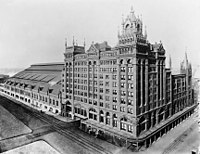Philadelphia, Baltimore and Washington Railroad
 Broad Street Station, Philadelphia housed the headquarters offices of the PB&W until 1930. | |
| Overview | |
|---|---|
| Headquarters | Philadelphia |
| Locale | Pennsylvania, Delaware, Maryland and Washington, D.C. |
| Dates of operation | 1902–1976 |
| Predecessor | Philadelphia, Wilmington and Baltimore Railroad; Baltimore and Potomac Railroad |
| Successor | Amtrak, ConRail |
| Technical | |
| Electrification | yes |
| Length | 717 miles (1,154 km) |
The Philadelphia, Baltimore and Washington Railroad (PB&W) was a railroad that operated in Pennsylvania, Delaware, Maryland and Washington, D.C. in the 20th century. The 131 mile (211 km) main line ran from Philadelphia to Washington.[1]: 228 The main line is currently known as a portion of the Northeast Corridor, owned by Amtrak.
History
The railroad was formed from a merger of the Philadelphia, Wilmington and Baltimore Railroad and the Baltimore and Potomac Railroad in 1902.[1]: 226 All three lines were controlled by the Pennsylvania Railroad (PRR). In 1907 the PB&W became a co-owner of the new Washington Terminal Company, which operated Washington Union Station.[2]
Acquisitions
The PB&W acquired the following railroad companies:
- 1906: South Chester Railroad
- 1913: Baltimore and Sparrow's Point Railroad
- 1916: Philadelphia and Baltimore Central Railroad, Columbia and Port Deposit Railway, Elkton and Middletown Railroad
As of 1916, the total track length of the system was 717 miles (1,154 km), including 9 miles of trackage rights.[1]: 226–227
Improvements
In 1928 the PRR began a program to electrify the main line between New York and Washington using overhead lines. Electrification of the PB&W portion was completed in 1935.[3]
Dissolution


The Pennsylvania Railroad merged into Penn Central Railroad in 1968, and the PB&W was then controlled by the new company. The Penn Central declared bankruptcy in 1970 but continued to operate trains until 1976, when the company's railroad assets were sold under the Railroad Revitalization and Regulatory Reform Act. Under the new law, Congress authorized sale of the PB&W right-of-way between Philadelphia and Washington, and related assets (such as the Washington Terminal Company), to Amtrak. Other PB&W assets were sold to the newly-formed Consolidated Rail Corporation (ConRail).[4]: 122 [5]
See also
- List of defunct Pennsylvania railroads
- List of Delaware railroads
- List of defunct Maryland railroads
- List of Washington, D.C. railroads
References
- ^ a b c Poors Intermediate Manual of Railroads. New York: Poor's Manual Co. 1917.
{{cite book}}: Cite has empty unknown parameter:|coauthors=(help) - ^ Tindall, William (1914). Standard History of the City of Washington. Knoxville, TN: H.W. Crew. p. 418. Retrieved 2009-09-16.
- ^ "Electrification History to 1948". Pennsylvania Railroad Electrification. www.railsandtrails.com. Retrieved 2010-05-24.
- ^ Schafer, Mike (1997). Pennsylvania Railroad. Osceola, WI: Motorbooks Intl. ISBN 0-7603-0379-7.
{{cite book}}: Unknown parameter|coauthors=ignored (|author=suggested) (help) - ^ "Penn Central Railroad." Accessed 2010-05-23.
- Companies affiliated with the Pennsylvania Railroad
- Defunct Pennsylvania railroads
- Defunct Delaware railroads
- Defunct Maryland railroads
- Defunct Washington, D.C. railroads
- Former Class I railroads in the United States
- Philadelphia, Baltimore and Washington Railroad
- Railway companies established in 1902
- Railway companies disestablished in 1976
